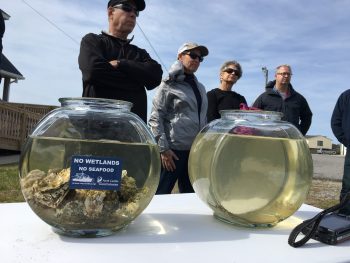 The North Carolina Coastal Federation’s Wanchese office was the first stop during March’s NC Coast Oyster Eco Tour, which gave participants a unique and close-up opportunity to learn about oyster aquaculture and restoration.
The North Carolina Coastal Federation’s Wanchese office was the first stop during March’s NC Coast Oyster Eco Tour, which gave participants a unique and close-up opportunity to learn about oyster aquaculture and restoration.
The oyster tour was part of the annual OBX Taste of the Beach event, which showcases local restaurants and cuisine through tours, tastings and culinary classes.
The Oyster Eco Tour featured local North Carolina oysters and a tour of Bodie Island Oysters’ lease operations, managed by Joey Daniels, in Pamlico Sound.
Participants started at the federation’s office, where they learned about oyster growing and about how oyster reef restoration projects help to keep coastal waters healthy. Erica Connery, AmeriCorps member at the Wanchese office, asked attendees to guess how many shells were in an oyster bag and to compare wave action on four different kinds of shorelines: sand, grass, bulkhead and a grass and oyster living shoreline.
She also set up a demonstration to show how oysters filter water. She filled two fish bowls with water, one with oysters and one without. When the tour group returned an hour later from visiting the lease site the bowl with oysters in it was noticeably cleaner.
Charles Hardy, a federation member and volunteer, said he was impressed with the example of how the oysters filtered the water in the fish bowls.
Hardy and other attendees also enjoyed time on the water with Joey Daniels of Bodie Island Oysters and Rowan Jacobsen, an award-winning author and oyster expert. Jacobsen coined the term “the Napa Valley of oysters” to describe North Carolina’s potential to grow and distribute oysters.
Daniels took them out to his lease on the Pamlico Sound and demonstrated how his oyster farm worked, as well as the ecosystem that oyster farming generates. Attendees also got to sample oysters on site.
Michael Serbousek, a member of and volunteer for the federation, as well as a member of the Wanchese office’s advisory committee, said the tour was “fantastic and very informational.”
Serbousek and his wife, Janie Serbousek, had attended the federation’s Sound Economic Development Summit earlier that week, and they said it was interesting to see what they had learned at the summit in action.
He said the most surprising part of the tour was seeing how complex oyster aquaculture is, in part because of how much equipment, time and resources need to be invested for a successful operation.
Hardy and Serbousek both mentioned learning about the tumbling process that helps develop “premium” oysters, which they did not know much about before the tour. Every three to four months, oysters are tumbled in machines to help improve their fullness and shape.
During the tour, Daniels pulled up a full frame of oysters so attendees could see the habitat and growing oysters — and an “astounding” amount of juvenile marine life, including crabs, shrimp and fish.
Serbousek said seeing the oyster filtration demonstration at the Wanchese office and then seeing the amount of juvenile marine life at the aquaculture site were the two most impressive parts of the tour.
“Oysters demonstrably clean the water, and aquaculture creates an environment that stimulates and supports the growth of many other forms of marine life,” he said.
